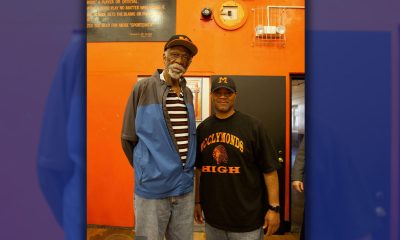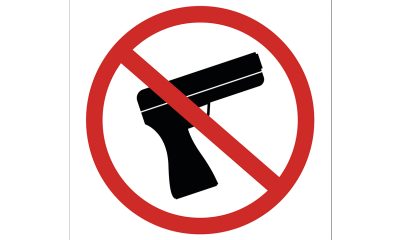Cincinnati Herald
Major League Soccer makes historic debut in Cincinnati with a win
CINCINNATI HERALD — Major League Soccer is now a part of the Cincinnati sports venue, following FC Cincinnati’s home opening win of 3-0 over the Portland, Oregon, Timers, Sunday evening at a sold out crowd at Nipper Stadium on the University of Cincinnati campus. The local futbol club, which gained Major League Soccer status last summer, packed the stadium for its first home game in the majors, defeating the Portland, Oregon, Timberwolves 3-4.
By FC Cincinnati reports and Ray Ball
Major League Soccer is now a part of the Cincinnati sports venue, following FC Cincinnati’s home opening win of 3-0 over the Portland, Oregon, Timers, Sunday evening at a sold out crowd at Nipper Stadium on the University of Cincinnati campus.
The local futbol club, which gained Major League Soccer status last summer, packed the stadium for its first home game in the majors, defeating the Portland, Oregon, Timberwolves 3-4.
Lauren Eylise, of Cincinnati, opened the historical home opener in singing the National Anthem.
Eylise is a hometown singer and songwriter, who has performed and toured nationally. She says it was an honor to welcome the newest member of the MLS right here in Cincinnati.
“These are the opportunities that are really worth it to me. FC Cincinnati joining the MLS really shows what can happen when you have the city’s support and commitment. I’ was excited to be singing in front of more than 32,000 fans, all celebrating soccer in Cincinnati,’’ she said.
A number of activities were planned for the home opener including a fireworks show and a panoramic photo.
Led by goals from Kendall Waston, Allan Cruz and Mathieu Deplagne, FC Cincinnati recorded their first MLS. After being awarded a free kick on the edge of their attacking third, FC Cincinnati opened the scoring in the 15th minute. Leonardo Bertone lofted a ball toward the far post, where a Kendall Waston header led to FC Cincinnati’s first MLS goal at Nippert Stadium.

FC Cincinnati’s Kendall Watson scored the first goal in the home opener against Portland Timbers. (Photo by: Michael Mitchell)
Following a deflected shot from Roland Lamah, Allan Cruz doubled the lead for the Orange and Blue in the 61st minute of action with a backheeled effort atop the six-yard box. Just two minutes later, Mathieu Deplagne capped off the scoring with FC Cincinnati’s third goal of the match.
Spencer Richey registered his first-ever MLS shutout and win in the match. The goalkeeper stopped three shots en route to earning FC Cincinnati’s first clean sheet of the season.
FC Cincinnati returns to action on Sunday, March 24, when the team travels to play the New England Revolution at 4 p.m. The match will be televised locally on WSTR 64, streamed locally on FloSports and carried on the radio on WDJO.
Lauren Eylise, who opened the match with her rendition of the National Anthem, staked her spot in the music industry with the release of her EP “Life/Death/Life” in September 2017. Though never formally educated in music, the development of Lauren’s craft was propelled by her passions for sound, exploring the depths of her soul. Her emergent repertoire has drawn streams from her homeland in Cincinnati to New York, and internationally in Germany, France and South Africa. In 2016, she was named Women In Charge’s Best R and B Artist of the Year.
This article originally appeared in the Cincinnati Herald.
#NNPA BlackPress
Inmates, Staff Worry About Care as Marion Prison Becomes One of Largest COVID Outbreaks in US
NNPA NEWSWIRE — According to state data that is updated daily, for Marion Correctional, as of May 1, staff members who reported positive results are 175; COVID-19 related staff deaths are 1; staff who have recovered are 98; units in quarantine include the full institution; inmates in quarantine are 430; inmates in isolation are 2016; inmates currently positive for COVID-19 are 2016; probable COVID-19 related deaths are 0; confirmed COVID-19 related deaths are 8; inmates who have pending results are 190; and inmates who have recovered are 69.
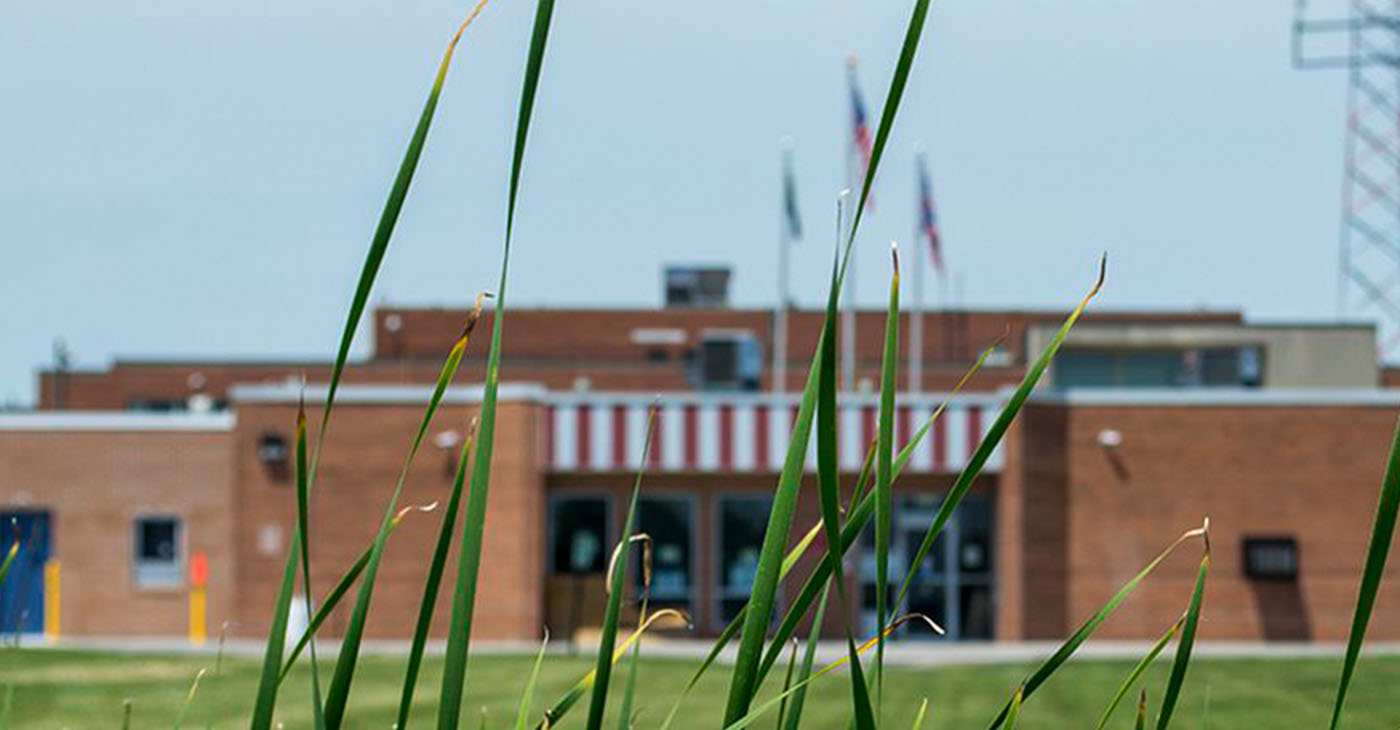
By Dan Yount, The Cincinnati Herald
The largest-known coronavirus hotspot in the country isn’t in New York or California: it’s the Marion Correctional Institution, an Ohio state prison about 50 miles north of Columbus.
According to state data that is updated daily, for Marion Correctional, as of May 1, staff members who reported positive results are 175; COVID-19 related staff deaths are 1; staff who have recovered are 98; units in quarantine include the full institution; inmates in quarantine are 430; inmates in isolation are 2016; inmates currently positive for COVID-19 are 2016; probable COVID-19 related deaths are 0; confirmed COVID-19 related deaths are 8; inmates who have pending results are 190; and inmates who have recovered are 69.
In the Ohio prison system, as of May 1, 6375 inmates have been tested; 937 tests are pending; 4072 tested positive; and 1906 tested negative.
Thus, more than 95 percent of the population at the minimum- and medium-security facility at Marion have tested positive for COVID-19. Combined, almost 16 percent of Ohio’s total coronavirus cases come from the Marion prison.
Gov. Mike DeWine ordered that every inmate at Marion and two other prisons be tested. Many of those who tested positive showed no symptoms.
Yet, the situation at Marion is worse than any correctional institution in the country.
Interviews conducted by cleveland.com with inmates and activists reveal a number of reasons they say are to blame, including lags in getting test results, inadequate cleaning, no social-distancing measures, and intense strains on their mental health.
Prisons, by their very nature, are some of the most vulnerable places to infectious outbreaks, as they contain a large group of people forced to remain in close quarters, with limited access to medical care. At Marion, some inmates are assigned to cells, while others are assigned to a dorm – a large room filled with bunk beds for dozens of people.
“There is no social distancing,” said Jonathan White, a 44-year-old Marion inmate from Cincinnati serving 15 years to life for murder, told cleveland.com. “You can’t get away from it.”
Inmate Emrie Smith also spoke to cleveland.com, saying he has been in the gym, where there is no social distancing, and after 8 p.m. there is only one toilet available for about 200 men.
White said prison officials didn’t start moving to isolate sick inmates until the disease spread throughout the population.
However, JoEllen Smith, a spokesperson for the Ohio Department of Corrections in Columbus, told the Herald preparations to keep the virus out of the prison began in early January. Also, ODOC officials have been conferencing with correctional officials in other states for best practices information during the entire outbreak. Smith provided a comprehensive list of conditions enforced at Marian and other state prisons to reduce the cases of the disease.
“There is so much anxiety about what is going on here with people’s health,” White added. “We view ourselves as an expendable population. So, when you see these types of numbers that are happening to us in prison, it’s almost expected – like, they (the authorities) don’t care.”
When asked why Marion in particular has so many COVID-19 cases — more than the rest of Ohio’s prison system combined — state prisons spokeswoman JoEllen Smith gave this answer:
“The Ohio Department of Rehabilitation and Correction has taken an aggressive and unique approach to testing, which includes mass testing of all staff and inmates at the Marion Correctional Institution, the Pickaway Correctional Institution, and the Franklin Medical Center (which is Ohio’s medical facility for inmates),” Smith stated in an email. “Because we are testing everyone – including those who are not showing symptoms – we are getting positive test results on individuals who otherwise would have never been tested because they were asymptomatic.”
Smith stated that after testing, inmates who show symptoms are immediately placed into isolation.
As for cleaning supplies, Smith stated that chemical boxes are delivered daily to each prison area, and the amount of disinfectant has been increased during the coronavirus crisis.
As for mental-health services, Smith stated that the state’s prisons agency offers “a full continuum of mental-health care within our facilities” using social distancing guidelines and proper personal protective equipment.
State prison officials are also developing plans to increase the use of tele-services for mental-health care if necessary, she stated.
Dozens of protestors stood outside Marion Correctional Facility Saturday holding signs to show support for their loved ones inside.
“I’m here fighting for my son’s life,” said Sabrina White, whose son, Richard Williams, has been incarcerated at Marion for over a year now. He has four more years left on his sentence.
In a Marion Star report, “Just recently, we have inmates in here that can’t even walk and breathe because of the virus,” said Austin Cooper, who has served over half of his six-year sentence for aggravated burglary and assault. “Medical just keeps sending them back out here to the camp, talking about they can’t do nothing for them.”
Inmate Jimmy Dzelajlija, who is serving a 17-year sentence for robbery and aggravated robbery in Cuyahoga County, talked to 5 On Your Side investigators by phone about the situation inside Marion Correctional.
He said despite being tested Friday, he has not received the results of his COVID-19 test.
“That’s the aggravating part, they won’t tell us,” said Dzelajlija. “We don’t know with the numbers that high, we don’t know if we’re the ones who have it.”
Numbers from Ohio’s Department of Rehabilitation and Correction show more than three out of every four inmates in the prison are infected.
“They passed out masks, we have little these little face masks that we wear,” said Dzelajlija. “Really, that’s to be honest, that’s it. We’re supposed to practice social distancing, but it’s impossible. My neighbor is literally three feet away from me, both sides, and behind me. There’s no way to practice social distancing here.”
“The frustration is building and building and building among everybody in here,” he said. “And tempers are flaring up on just the slightest provocation.”
“I saw the numbers and I just broke down bawling,” said Azzurra Crispino in a report in the Marion Star newspaper.
Dr. Amy Acton, the director of Ohio’s Department of Health, echoed that.
“As we know, there is a significant amount of the population who are really being carriers or vectors without even realizing it,” Acton said.
And that’s what scares Crispino. She said even if you don’t care about the health of inmates, the threat of workers contracting the virus and carrying it outside prison walls and into the community is real.
“The virus doesn’t distinguish between why the person is in that facility,” said Crispino. “From the virus’ perspective, they are still eligible hosts.”
It’s why she believes it’s time for the state to seriously look at reducing its prison population to try and slow the spread of the virus.
“This is a human rights travesty and public health crisis,” said Crispino.
Department of Correction Director Chambers-Smith was part of the Governor’s press conference April 30.
“Individuals who test positive are placed in an area of the facility, which is separate from the general population. Also, our comprehensive testing approach of staff and inmates has assisted us in identifying asymptomatic individuals who have tested positive who can now be isolated from others in order to prevent further spread.
DRC’s preparation began for the potential impact of COVID early this year, Smith said. This included tabletop exercises and frequent discussion with counterparts across the county. Director Chambers-Smith presented during a national webinar the best practices in preparation for COVID for correctional facilities.
DRC continues to work closely with the Ohio Department of Health in implementing operational changes as we address the challenges associated with COVID-19, Smith said.
Smith said DRC has taken extensive steps in response to COVID, including but not limited to:
- Prior to COVID-19, as part of our normal infectious disease control efforts, we routinely offer annual influenza vaccines to all offenders in our prison who wanted one, and especially targeted our at-risk and chronic care caseloads.
- We have issued numerous communications to our staff and inmates, including education about COVID-19 and reminders to engage in aggressive hand washing and social distancing where possible.
- The prisons have sanitation crews who frequently disinfect common surfaces with a chemical effective against COVID-19 in line with public health recommendations.
- We are using technology and other methods to reduce staff and offender gatherings including using tele-conferencing for our new officer training.
- We implemented a text messaging system for staff to be able to easily check in with their loved ones while they are at work as cell phones are not permitted within the facilities.
- A family phone number and email address have been established and published to help answer questions about the impact COVID-19 is having on our operations. Individuals can email the DRC atcovid19@odrc.state.oh.us or call 614-728-1142.
- We have implemented COVID-19 specific health screening for all inmates entering our prisons.
- Volunteer activities and visiting have been suspended.
- Only staff and mission critical contractors are permitted into the facilities. Health screenings are in place for staff and contractors who are entering the facilities/offices.
- Staff and the incarcerated population are permitted to wear protective masks.
- We have suspended travel for all state employees to only tasks that are mission critical.
- The director issued an executive order to county jails regarding the screening of inmates before being transferred to our reception centers.
- Reception inmates will be housed in the same area by date of arrival for a minimum of 5 weeks to monitor them for any symptoms.
- Inmate work assignments, which are not on state property, have been suspended.
- Most facilities are serving two meals per day – a hot brunch meal and a hot evening meal. This is being done to ensure we have less movement and less contact to reduce the potential spread of COVID-19. Commissary prices are being reduced as well to assist residents in being able to purchase food and other goods.
- State Highway Patrol is providing perimeter security at three facilities.
#NNPA BlackPress
IN MEMORIAM: The Honorable Nathaniel R. Jones
NNPA NEWSWIRE — “Nathaniel Jones is a pioneer who has never failed to stand for the rights of people denied a chance to be a part of the process,” said Roslyn A. Brock, chairman of the NAACP National Board of Directors. “His distinguished career serves as inspiration to our thousands of youth leaders working to end the profound segregation that continues to exist in our society to this day.
Focused on equal opportunity under law
By Dan Yount, The Cincinnati Herald
Equal opportunity under the law. It was the focus of Federal Judge and Civil Rights leader Nathaniel R. Jones’ life for decades, and he has made more of a difference than most people. Judge Jones died of congestive heart failure January 26 at his home in East Walnut Hills, according to his daughter Stephanie Jones, Esq. He was 93.
Jones was born in Youngstown in 1926, 17 years after the founding of the NAACP and the publication of The Call, a document “imploring Americans to discuss and protest the racial problem and to renew the struggle for civil and political rights.” That document deeply influenced him, as did his mentor, J. Maynard Dickerson, according to his autobiography, Answering the Call.
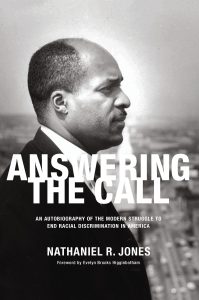
Judge Nathaniel Jones is shown in this cover photograph on his autobiography Answering the Call that was taken in his hometown of Youngstown about a month after he had served as deputy general counsel on the Kerner Commission. Provided.
After growing up in an integrated neighborhood, Jones writes he learned a hard lesson in “deeply entrenched and pervasive” segregation when he joined the Army in 1945. Attending college on the GI Bill, he enrolled in a pre-law course, continued with law school at night, and became involved in Civil Rights issues, increasingly conscious of the ways that racism was built into voting, housing, health benefits, jobs, and education.
A graduate of his hometown school, Youngstown State University, Jones chose a legal career to help eliminate racial injustice — the kind that led to his being refused a shave in the old Sheraton Gibson barbershop during an early visit to Cincinnati. He earned his law degree from Youngstown State University. In 2003, the federal courthouse in Youngstown was named after Judge Jones.
A year after entering private practice, Jones became the first African American in Ohio to be an Assistant U.S. Attorney, when he was appointed to the Northern District of Ohio at Cleveland, a position he held until 1967.
He then was asked by his friend Merle McCurdy to serve as assistant general counsel to President Johnson’s National Advisory Commission on Civil Disorders, also known as the Kerner Commission, which made a study of the causes of the urban riots of the 1960s. McCurdy was the commission’s general counsel.
Jones said the commission’s February 1968 report known as the Kerner Report, concluded that the nation was “moving toward two societies, one Black, one White—separate and unequal.” Unless conditions were remedied, the commission warned, the country faced a “system of apartheid” in its major cities.
Jones succeeded Thurgood Marshall as general counsel for the NAACP in the 1970s. His work for the NAACP focused on desegregation, notably in the North, where judges were not convinced that the Brown v. Board of Education decision applied, and on landmark affirmative action cases.
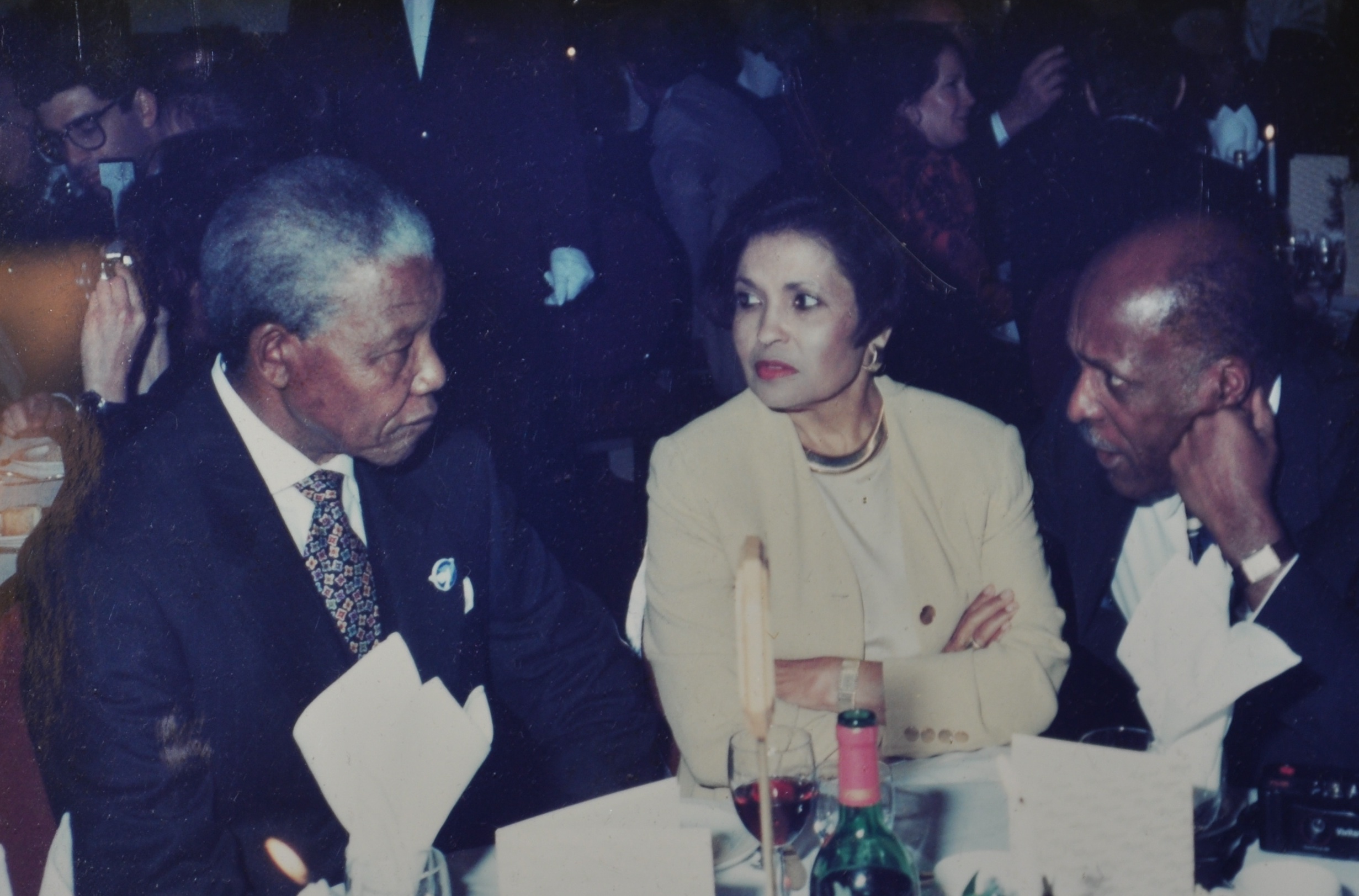
Dinner with South African President Nelson Mandela. In a once-in-a-lifetime experience, Cincinnati federal Judge Nathaniel Jones and his late wife Lillian were asked to dine with South African President Nelson Mandela during Jones’ second visit to the country when he assisted in the drafting of a new constitution for South Africa. Photo provided
From 1969 to 1978, Jones’ work for the NAACP took him to the Supreme Court multiple times, where he argued for affirmative action in the public and private sectors, challenged efforts to maintain segregated schools in jurisdictions across the United States, and successfully defended the NAACP against attempts by Mississippi businesses and officials to bankrupt the organization through civil lawsuits brought by the targets of mass boycotts and protests in that state.
Jones also fought to overturn racial discrimination against Black people across Africa in the 1990s, working with South African President Nelson Mandela and others to write a new constitution for South Africa following the apartheid era.
“Nathaniel Jones is a pioneer who has never failed to stand for the rights of people denied a chance to be a part of the process,” said Roslyn A. Brock, chairman of the NAACP National Board of Directors. “His distinguished career serves as inspiration to our thousands of youth leaders working to end the profound segregation that continues to exist in our society to this day.
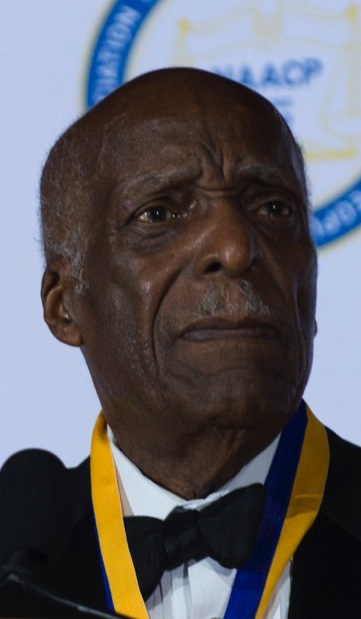
Judge Nathaniel R. Jones. Photos by Pete Coleman/The Cincinnati Herald
Judge Jones was appointed by President Carter to the U.S. Court of Appeals for the Sixth Circuit in Cincinnati in 1979. Judge Jones retired from the Sixth Circuit Court in 2002, and continued to practice law, serving as senior counsel at the firm of Blank Rome LLP until 2018.
“I see enough here to make Cincinnati an exciting place,” said Jones. “People should be proud and press on to make this city an even better place to live.”
During the 101st National NAACP Convention in 2016 in Cincinnati, Judge Jones said in receiving the NAACP’s highest honor, the Spingarn Medal, “Democracy requires participation. If you don’t participate, you don’t have anybody to blame but yourself. To be a player, you have to be involved. I recognize both the blessing of 90 years and the finite character of what is left of my life, but as long as I have breath, my advice will be to stay focused and resist efforts on the real threat, which is the nullification of the remedies that give meaning to laws against discrimination.
“I want to issue a plea to all who still believe in the NAACP’s call, some 107 years after our founding in 1909. The original Call concluded: “Hence we call upon all the believers in democracy to join in a national conference for the discussion of present evils, the voicing of protests, and the renewal of the struggle for civil and political liberty.
“This is why I am truly honored to be part of the continuing legacy of Spingarn Medalists.’’
Mayor John Cranley, on the passing of Judge Nathaniel Jones, said, in a statement, “Nathaniel Jones was one of the greatest Civil Rights leaders this nation has ever known, having worked with Thurgood Marshall during the Brown v Board case, desegregating countless schools and institutions as head of the NAACP Legal Defense Fund, to helping South Africa come out of apartheid, to ensuring individual rights as a federal judge. To be in his presence was to be in the presence of greatness. Knowing him has been one of the greatest honors of my life.
“In 2001, he helped me write my first major piece of legislation, the city’s racial profiling ban—that’s the equivalent of getting hitting lessons from Hank Aaron. Among Salmon Chase, Harriet Beecher Stowe, William Howard Taft and Fred Shuttlesworth, Nathaniel Jones was one of the five greatest Cincinnatians to have ever lived among us.”
Former Ohio State Senator Eric H. Kearney remembers being in his early 20s and meeting Judge Jones at the home of family friend, Civil Rights activist Virginia Coffey. Kearney said, “To our community, Nathaniel Jones was a judge, lawyer, educator, and determined defender of social justice. To his family, he was a dedicated father and grandfather. To me, Judge Jones was a mentor, law school professor, and inspiration. Our region, our nation and our world are a better place thanks to his contributions. Judge Jones will be dearly missed.”
In a statement, a representative of the family of the late State Representative William Mallory, said, “Judge Nathaniel R. Jones was a great legal scholar and a confidant to our beloved William L. Mallory Sr. He called Judge Jones to ask if he had a chance to file a lawsuit to change the way judges are elected in Hamilton County. The historic lawsuit was successful and Judge Jones is a big part of that success. He gave an inspiring commencement speech at the law school graduation of Judge Dwane Mallory. He was a humble man who carried himself with great honor and distinction. He fought for democracy here in Cincinnati and all over the world. He had a unique relationship with the Mallory family, and we will miss him. We send our prayers and condolences to the family of Judge Nathaniel R. Jones.’’
Although thrilled at Barack Obama’s “amazing election,” in the discourse surrounding it, Jones writes in Answering the Call, he was reminded of the need to keep Civil Rights history alive for the media, Congress and the judiciary.
Jones praises Civil Rights lawyers for tirelessly establishing legal standards and fighting federal efforts to thwart them. He mentored and inspired many young people by teaching classes at the University of Cincinnati Law School and Harvard Law School. Judge Jones was actively involved in the Summer Work Experience in Law (SWEL) program in Cincinnati.
He felt that the legal community in Cincinnati was too segregated, so with his friend, the late Judge Robert Black, he established the CBA-BLAC (Cincinnati Bar Association-Black Lawyers Association of Cincinnati) Roundtable to foster better relationships with attorneys of different races and ethnic backgrounds.
Among his numerous honors and awards, Judge Jones was named a Great Living Cincinnatian in 1997. He changed the course of history, and we are grateful.
#NNPA BlackPress
Black nurse practitioners seek more diversity in profession
NNPA NEWSWIRE — Cincinnati’s Black Nurse Practitioners has joined forces to build impactful relationships, empower students and nurses, strengthen its presence in advanced and leadership roles, as well as minimizing healthcare disparities. The organization is inviting the public to Cincinnati’s Black Nurse Practitioner Networking event on Saturday, November 2, from 12 to 3 p.m. at Mallard Lakes Townhomes’ Clubhouse at 12100 Lake Circle Drive, in Springdale/Cincinnati, 45246.
By Dan Yount, The Cincinnati Herald
CINCINNATI – Cincinnati Black Nurse Practitioners, which represents about 30 female Black nurse practitioners in the Cincinnati area, is seeking an increase in their numbers to better serve local minority communities.
Felicia Beckham, MSN, FNP-BC, RN, said, “The gender/race composition of my profession of nurse practitioners is 93% female, but only 5.7% are Black. Due to the underrepresentation, minorities receive unequal treatment and we are unable to meet cultural needs/demands of our patients, families and communities.
“We have to create a stronger voice to help influence equity and inclusiveness within the healthcare system.’’
Thus, Cincinnati’s Black Nurse Practitioners has joined forces to build impactful relationships, empower students and nurses, strengthen its presence in advanced and leadership roles, as well as minimizing healthcare disparities. The organization is inviting the public to Cincinnati’s Black Nurse Practitioner Networking event on Saturday, November 2, from 12 to 3 p.m. at Mallard Lakes Townhomes’ Clubhouse at 12100 Lake Circle Drive, in Springdale/Cincinnati, 45246.
An advanced practice registered nurse (APRN) is defined as nurse educated at a master’s or post-master’s level in a specific role and patient population. There are four APRN roles: Certified Registered Nurse Anesthetist (CRNA), Certified Nurse-Midwife (CMN), Clinical Nurse Specialist (CNS) and Certified Nurse Practitioner (CNP).
According to Beckham, the APRN is qualified and trained to assess patient’s needs, order and interpret diagnostic and laboratory tests, diagnose medical conditions, prescribe medication and formulate treatment plans. Nurse practitioners are licensed to take care of patients throughout their lifespan without the direct supervision of a doctor.
“We are essential to meeting the growing healthcare demand in the United States,’’ Beckham said.
Statistics indicate minority ethnicities are underrepresented within the CNP workforce. Gender breakdown of APRNs are 89.5% female, 10.5% male. Racial breakdown of APRNs are 85.7% White, 6.6% African American, 5.8% Asian, 3.4% Latina.
“A diverse nurse practitioner workforce is vital to fulfilling the needs of communities in the most equitable way. To improve the healthcare trajectory of vulnerable populations, understanding the components that impact a patient’s well-being is key,’’ Beckham said.
According to Dr. Ramona Benkert, associate professor, College of Nursing, Wayne State University, Detroit, African American patients have experienced unequal and discriminatory treatment, which can result in a cultural mistrust of the provider. When a patient and practitioner’s race/ethnicity/culture align, an environment is created to increase engagement, build trust and improve healthcare outcomes.
“As nurse practitioners of color, we have the opportunity break down barriers to provide inclusive, culturally competent health care services to everyone. As an organization, we can use our collective experiences and expertise to create a stronger voice to influence healthcare,’’ said Beckham.
Felicia Beckham, Cincinnati native, who is a Board-Certified Family Nurse Practitioner and author of Diversifying the Medical Field.
-

 Activism4 weeks ago
Activism4 weeks agoUndocumented Workers Are Struggling to Feed Themselves. Slashed Budgets and New Immigration Policies Bring Fresh Challenges
-

 Activism2 weeks ago
Activism2 weeks agoWe Fought on Opposite Sides of the Sheng Thao Recall. Here’s Why We’re Uniting Behind Barbara Lee for Oakland Mayor
-

 Activism4 weeks ago
Activism4 weeks agoOakland Post: Week of March 5 – 11, 2025
-

 #NNPA BlackPress2 weeks ago
#NNPA BlackPress2 weeks agoRev. Dr. Jamal Bryant’s Black Church Target Boycott Mobilizes 150,000
-

 Activism2 weeks ago
Activism2 weeks agoSan Francisco Is Investing Millions to Address Food Insecurity. Is Oakland Doing the Same?
-

 #NNPA BlackPress4 weeks ago
#NNPA BlackPress4 weeks agoTrump Moves to Dismantle Education Department
-

 #NNPA BlackPress4 weeks ago
#NNPA BlackPress4 weeks agoFighting to Keep Blackness
-

 #NNPA BlackPress2 weeks ago
#NNPA BlackPress2 weeks agoRecently Approved Budget Plan Favors Wealthy, Slashes Aid to Low-Income Americans


